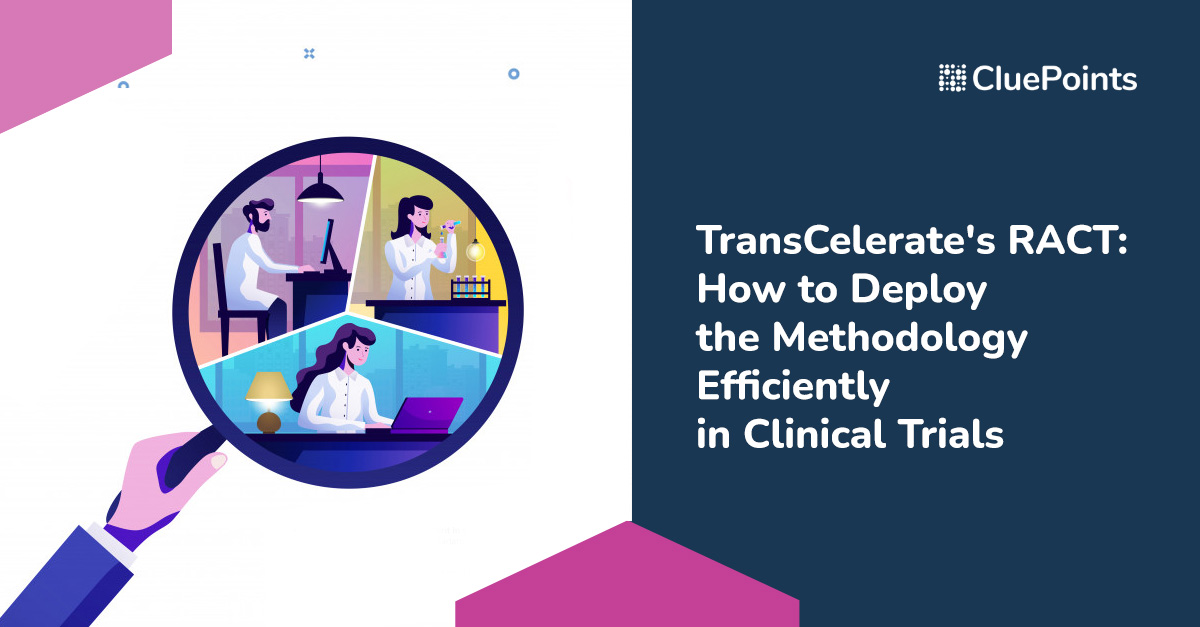The move towards risk-based monitoring promises to bring clinical trials into the 21st century by driving the efficient delivery of life-changing new medicines. But while the TransCelerate RACT, or Risk Assessment Categorization Tool (RACT), provides us with a framework, it is not very practical for everyday use.
CluePoint’s RACT risk assessment software is a free tool that allows sponsors and contract research organizations (CROs) to more conveniently follow TransCelerate’s methodology – boosting participant safety and improving the chances of success.
What is the TransCelerate RACT?
According to its website, TransCelerate BioPharma is a non-profit on a mission: to collaborate across the global biopharmaceutical research and development community to identify, prioritize, design, and facilitate the implementation of solutions that drive the efficient, effective, and high-quality delivery of new medicines.
It is a bold ambition, and one that rests on the fundamental need to modernize clinical research. Current methodologies are rife with inefficiencies. Ensuring data quality relies on the time- and resource-hungry process of source data validation (SDV) – an imperfect method that will only become more problematic as the volume of data points collected during studies continues to increase.
Enter risk-based monitoring (RBM), a FDA, EMA, ICH-backed approach to protecting data quality, boosting participant safety, and improving a trial’s chances of operational success.
What is a RACT risk assessment?
RBM is the process of identifying, assessing, monitoring, and mitigating the risks that could affect the quality or safety of a clinical trial. It is a proactive approach that allows the study team to move away from 100% SDV, and instead focus resources on high-value tasks.
First written into US and European guidelines back in 2013, RBM received further validation with the publication of the ICH E6 (R2) in 2016. TransCelerate has published its RBM methodology help pharmaceutical companies, sponsors, and CROs to embed this new way of working into their processes.
The methodology includes the RACT – a risk identification process that empowers trial designers to evaluate study risks, and organize them into categories:
- Safety study phase
- Complexity
- Subject population
- Technology
- Data collection/ CRF source
- End points
- Organizational experience
- Investigational product/ study medication
- IP logistics / supply chain
- Blinding
- Operational complexity
- Geography
To use the tool, study teams assess impact, probability, and detectability in relation to a variety of questions. The tool then generates a risk score for each category.
But despite the robust nature of TransCelerate’s overall RMB methodology, the RACT does contain some inherent weaknesses.
It can, for example, return subjective results. Questions are answered by individual study team members, who will tend to see risk through the lens of their own experience or role. This can hamper protocol to protocol consistency and project reproducibility.
The tool also lacks ease of use and does not lend itself to collaborative working. For example, it utilises Excel spreadsheets, demanding strict version control protocols and introducing the risk of error.
In short, the tool is valuable but inconvenient, particularly when used in line with its original intention: i.e. before study commencement and throughout the trial. Crucially, these weaknesses introduce elements of risk to the risk assessment process.
What is the CluePoints RACT?
TransCelerate states that the adoption of RACT in clinical trials is instrumental in the identification of potential risk factors that may impact studies, and lead to the delay or even the refusal of regulatory submission.
While its RACT provides clarity on the factors for consideration, however, it doesn’t provide the most efficient way to apply them to studies. But CluePoints hopes to support the spirit of the initiative.
CluePoints RACT is a free, online software product that enables study teams to conveniently and objectively identify, interpret, and document the risk assessment outcomes as per TransCelerate’s methodology.
It allows users to:
- Answer questions in term of detectability, impact, and likelihood in line with the TransCelerate methodology
- Customize categories in order of impact, probability, and detectability
- Customize category definitions, questions, and weight
- Define reference value fields such as the impact on monitoring plans
- Document potential risk factors and decisions
- Define mitigations and associated KRIs for identified risks
- Generate a PDF list of actionable items

